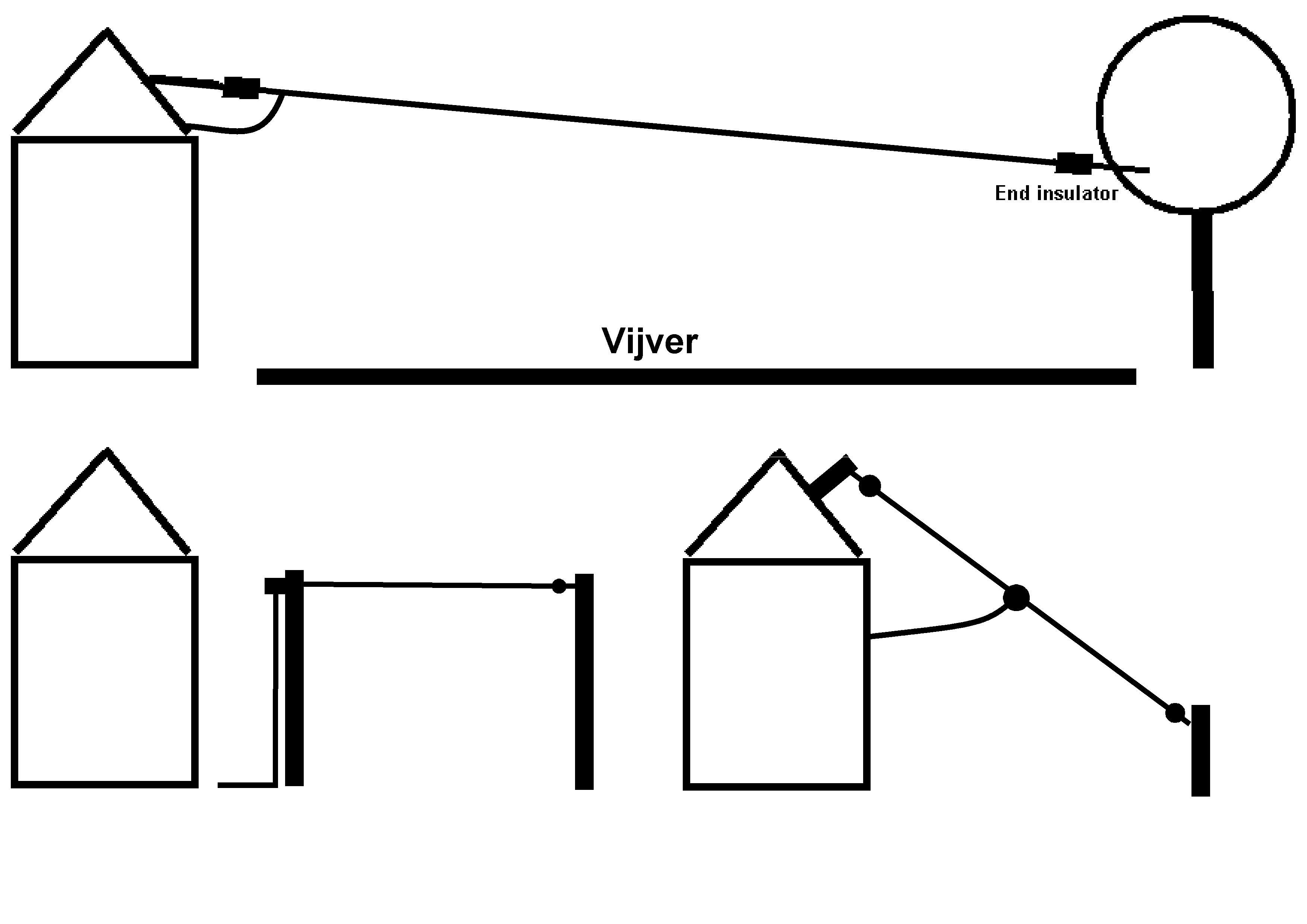 For an 80 m band antenna, i only was able to install ONE SINGLE WIRE,
with a maximal length of 50 m, running in an angle of about 90 degr. from my
house to a tree.
For an 80 m band antenna, i only was able to install ONE SINGLE WIRE,
with a maximal length of 50 m, running in an angle of about 90 degr. from my
house to a tree.|
-PA0NHC- dipole antenna for 80 to 20 mtrs, |
Antenna construction
(20200616).
NEW choke
construction (Update
20220401)
Feeder common mode problems cured
(20200616).
The influence of
temperature changes in Common Mode Chokes
(20200530)
The
(your?) problem.
 For an 80 m band antenna, i only was able to install ONE SINGLE WIRE,
with a maximal length of 50 m, running in an angle of about 90 degr. from my
house to a tree.
For an 80 m band antenna, i only was able to install ONE SINGLE WIRE,
with a maximal length of 50 m, running in an angle of about 90 degr. from my
house to a tree.
I constructed an "End Fed" antenna, and later a "Zeppeling" antenna.
They radiated relative weak signals,
and received loud noises from electronic equipment from the neighborhood,
and RF interference from my house.
For instance, while CWing :
- The refrigerator was beeping.
- The radio and TV plopping.
- The gas heather flame was amplitude modulated.
- Distorted modulation (feedback)
- "Hot" transmitter chassis (burning my finger).
Why? The antenna was fed onto one end. and
therefore electrically fully asymmetrical.
In other words : It was electrically fully UNbalanced.
It had to use all surrounding metal objects as an RF current return path to the
transmitter.
The heather, refrigerator, radio and TV acted as a counterpoise. They all
became a part of the antenna system.
Do you have the same antenna problems as i had?
Do you want a coax fed, noise free, RFI free antenna ?
But only can span a wire
at nearly a right angle away from the shack ?
Then read the article below, you find the solution here!
The solution :
Use a horizontal polarized, pure "symmetrical" antenna.
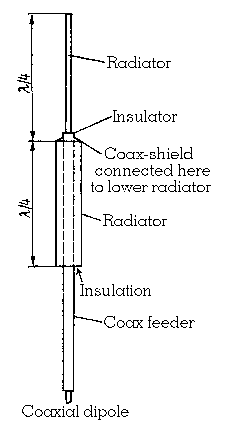 1. In other words: use an in its center powered dipole.
1. In other words: use an in its center powered dipole.
2. Then one half of the antenna balances the other half and
3. The most active part of the antenna is then around the midpoint, far away from the
house and
4. The feeder + the house are in the direction of the MINIMUM field
strength of the dipole radiation
pattern.
Problem : For a conventional horizontal dipole, the feeder should run down at a right angle to the
center of the antenna.
That was impossible for me.
How to combine the
wanted properties of both :
The zeppelin antenna
The feeder mechanically connected
to one end of the
antenna,
and running in the same direction as the radiator
and
The dipole antenna
The feeder electrically connected at the center of the
antenna.
The
combination of these demands lead to a
coaxial dipole.
This is a vertical polarized omni directional
VHF antenna, made of pipes and rods. The antenna stand pipe acts as coax feeder
and is connected to the open center of the 1/2 wave long radiator. The lower
part of the radiator acts as a BALUN (a so called "bazooka"), and
decouples the feeder from the radiator.
The feeder runs to one end of the radiator, but feeds the center of the radiator. As a result, the feeder is in line with the radiator, in the minimum of its radiation pattern, and the antenna is electrically symmetrical. This was exactly what i wanted. So "simply" turn the coaxial dipole 90 degr. to the horizontal position, make it resonant on 80m, and you have in principle the antenna described here below.
.
How
an antenna choke works.
Coax screening
contains TWO skin layers which (for high frequencies) are separated
from each other :
1. One skin layer ("Skin2") is on the INside of the screening. This
internal circuit is called the Differential Mode circuit. It only carries energy
which runs to and from the antenna. Skin2
does not interact with the outside world.

2. On the OUTside of the screening a second skin layer "SKIN1" exists.
This outside circuit is called the Common Mode circuit.
It interacts with the outside world and receives signals and noises from the surrounding.
It therefore carries noise currents, which will run towards the antenna and the transceiver.
It also "see" ferrite cores which are placed over the coax.
Well constructed Ferrite coils can couple very high impedances in
series with this common mode circuit, thereby vastly reducing common
mode currents.
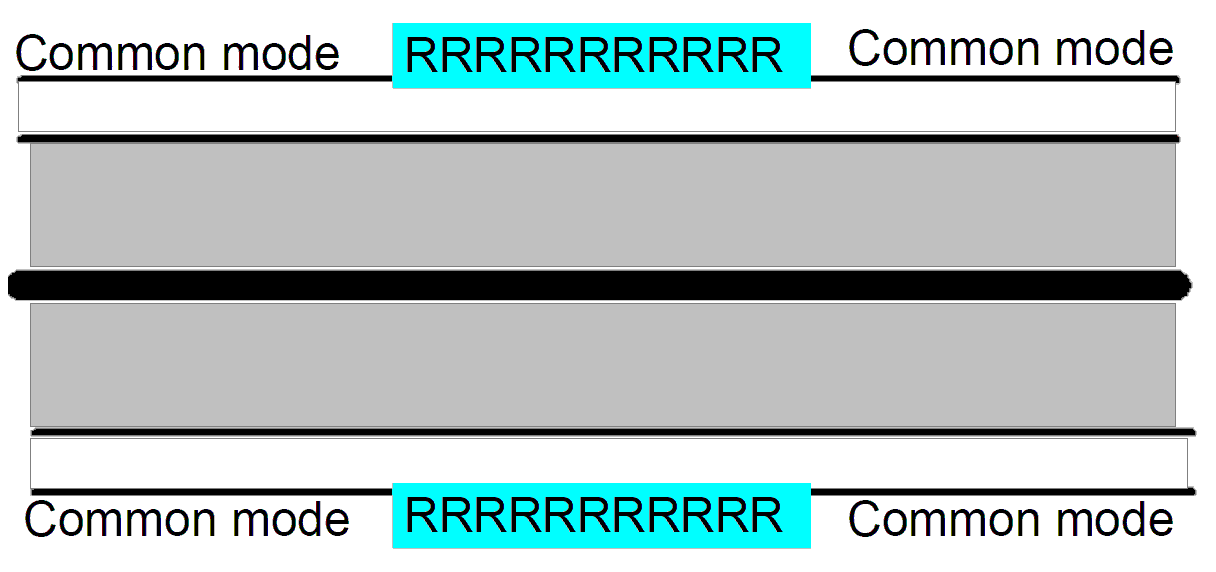
At abt. 20m distance from the end of the coax
part, the high impedance of such a Common
Mode Choke (CMC) is coupled
in SERIES with Skin1.
This results in an electrically "ending" Skin1 at that point. The
outer skin of the last 20m coax now is a 1/4 wave long dipole half.
That part carries two RF-currents :
- One non-radiating differential mode current
inside the coax towards the feed point (middle) of the antenna.
- One radiating common mode current on the
outside of the screening, running from the feed point backwards to the
antenna choke.
 The end impedance of a dipole can be several kilo Ohms.
The end impedance of a dipole can be several kilo Ohms.
The impedance of the choke must
be much higher and resistive of nature to prevent detuning of the antenna.
The
antenna choke must therefore be constructed using 61mm #31 ferrite cores, with
four of these CMCs connected in series.
Feed point.
At the feed point, the coax inner conductor is connected to the
19m long
stainless steel wire, which radiates the supplied energy.
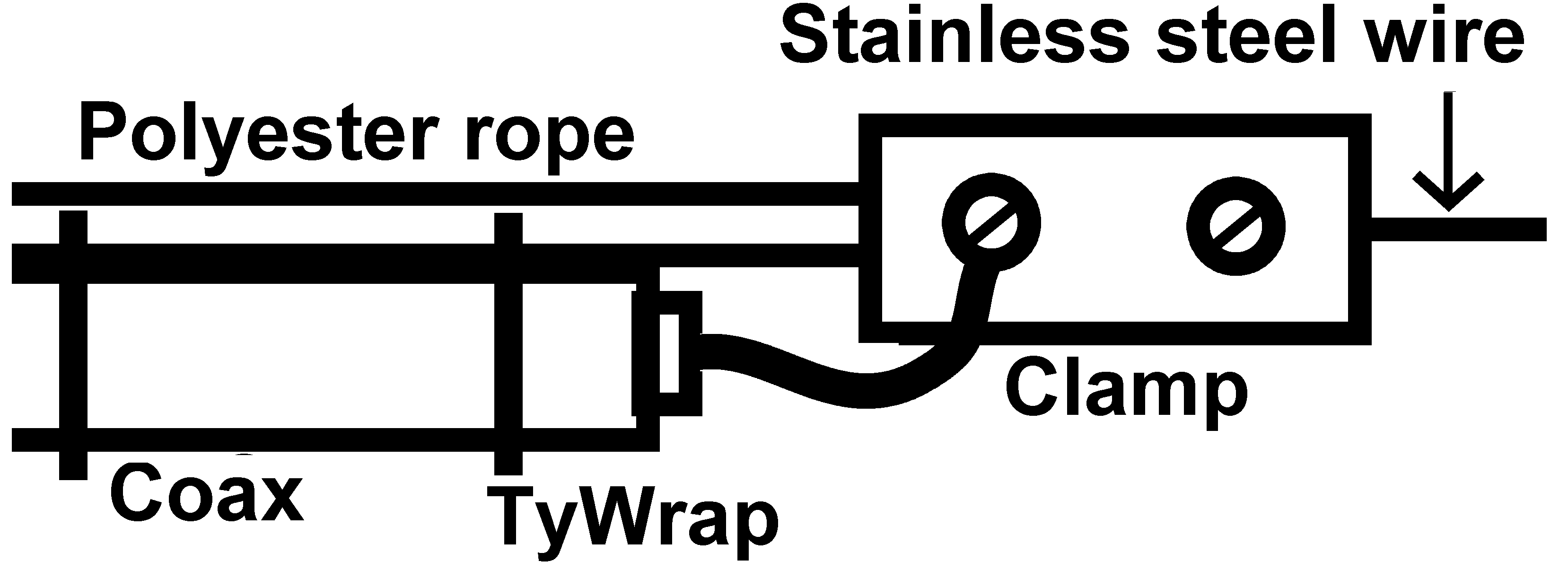 The
20m long coax screening is kept isolated from the inner conductor.
The
20m long coax screening is kept isolated from the inner conductor.
The screening inner skin must be soldered in contact with to the screening outer
skin, and is further connected nowhere.
The current at the screening skin layer (Skin2) differential mode circuit will
then jump to the outside common mode circuit, where it is radiated.
As the antenna feed point is electrically open, static charges onto the wire part must be discharged to ground at the antenna connection of the transmitter.
Feed point impedance.
On 80m the 40m long antenna is a half wave long, has a low VSWR into 50 Ohms, and probably needs no extra matching.
On 40m the antenna is a full wave long, and has a high feed point impedance (over 1 kOhm). The VSWR in the 50 ohms coax cable then becomes very high. But the cable losses are still low, due to the relatively low operating frequency.
At the transmitter side of the coax cable, the impedance can be anything then, depending on the total length of the coax cable and the working frequency.
Feeder length.
When the TOTAL electrical
length of the coax (antenna + feeder) for the used frequency is an odd number of 1/4 wave lengths,
the coax line can act as an impedance transformer. A high antenna feed point
impedance will be transformed to very low impedance at the transmitter site and
vice versa.
At 3.65 MHz the antenna shows an impedance near 50 Ohms, causing the coax length to be UNcritical for the 80m band.
If at other bands than 80m the transmitter matching
shows to be difficult, the feeder impedance at the
transmitter site can be changed, by extending the coax feeder a bit.
|
WARNING: do not try to match a VSRW higher than
1:3 with a build-in automatic tuner in your transceiver, using more than e few watts
! |
The coax feed line of this system
is insensitive to energy radiated by the dipole.
The feed line of this antenna runs in the MINIMUM of the antenna
radiation pattern, and at a right angle to the building. The building therefore is also
in the MINIMUM
of the antenna radiation pattern. Resulting in no RF power on the outside of the
coax feeder and NO RF in the house.
|
BUT : |
If there is not
enough room to stretch a 40m long wire.
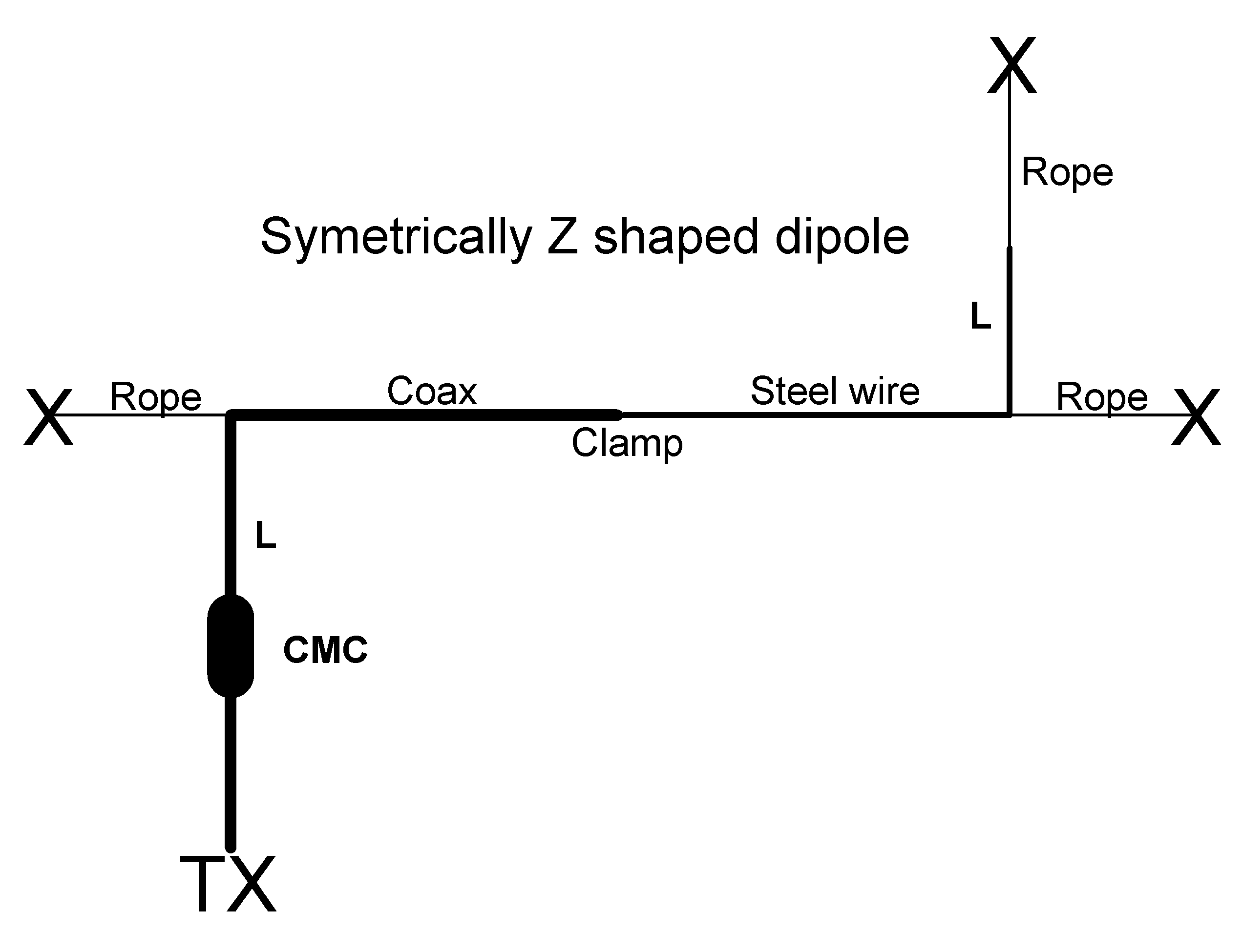 Still use a 40mtrs long dipole. Bend both ends of the radiating part of the antenna at an angle of
90 degr. The antenna becomes (seen on top)
Z-shaped. It still matches at 80mtrs. As the biggest part of the RF-current is running
from the center of the antenna, this trick it has little negative effect on the
antenna efficiency.
Still use a 40mtrs long dipole. Bend both ends of the radiating part of the antenna at an angle of
90 degr. The antenna becomes (seen on top)
Z-shaped. It still matches at 80mtrs. As the biggest part of the RF-current is running
from the center of the antenna, this trick it has little negative effect on the
antenna efficiency.
If you cannot install a full 40m
wire length at all.
Just install the max length you can.
But keep the two radiating center parts of the antenna symmetrical in
length.
In other words: keep equal length for both dipole halves. The antenna will work less good on lower frequencies, but will still work and will be symmetrical, with all the positive effects. You have to use a tuner anyhow. And remember : high SWR on 80m / 60m / 40m does not cause much cable losses.
Don't worry for not ideal SWR at 1.8 / 3.65 / 7.1 MHz..
On 14 MHz the S/N will not be influenced.
Coax.
For 100 W power (400 W on 80m) you could use :
- 5mm Belden H155 double screening and small bending radius, moist
resist foam dielectric
- 5mm RG300 PTFE silver plated, double screening, small bending
radius, high temperature.
- 5mm RG223/U silver plated, double screening and small bending
radius/
REM : coax with water inside is unusable and must be replaced. Pay attention to water protection.
Cable ties.
Use ONLY black cable ties of the best
quality (Tywrap with metal tooth)..
They should not weaken in UV sunlight, should not slide loose, and should be strong.
Use small
ones for the coax, and larger ones for the choke.
Dont be stupid as i was, experimenting with cheaper types.
The rope.
Only use pre-streched polyester flags line rope
(4-6 mm dia.).
Do NOT use nylon! (this lengthens when loaded, then putting stress on the
coax, and hardens due to sunlight-UV).
Antenna location.
The antenna radiates and receives the most near the feed point, that is the
center of the radiating part ! That is the MIDPOINT of the antenna between the far
open end and the choke.
So keep this area as far away as possible from surroundings and noise-radiating sources. Keep that dipole-part straight and high.
Run, if possible, the coax cable part between your transceiver and antenna at 90 degr. to the dipole length axis.
Static's can build up
easily, as there is NO connection between inner and outer conductors of the feed cable.
Protect the coax, your transceiver and yourself by using a coaxial lightning-arrestor in the feed line and a good
NOISE FREE safety-earth. READ this
pse.

Pse let me know, if you did build the end-fed dipole. I am interested in your results.